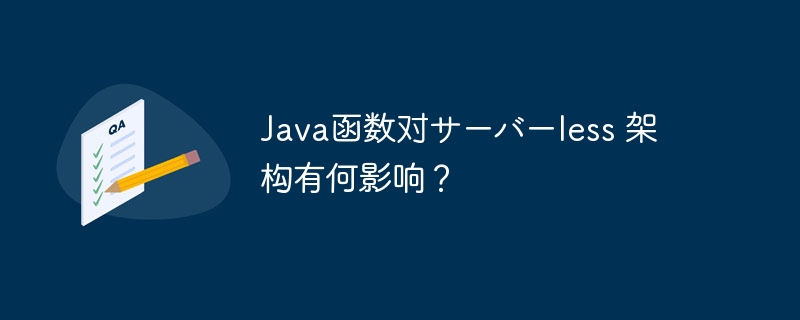Java 函数在无服务器架构中提供以下优势:可扩展性、成本优化、上市时间加快和维护负担軽减。以下步骤说明了如何使用 Java 函数构建无服务器应用程序:选择云提供商,创建账户,创建函数,部署函数和配置触发器。实战案例包括使用 AWS Lambda 构建图像处理应用程序和使用 Google Cloud Functions 触发电子邮件通知。

Java 函数对无服务器架构的影响
引言
无服务器架构已成为应用程序开发的流行选择,它使用按需支付的云服务,而无需管理基础设施。 Java 函数在无服务器架构中扮演着关键角色,提供了一种轻松创建可扩展、可维护应用程序的方法。
Java 函数和无服务器架构的优势
如何使用Java 函数构建无服务器应用程序
以下是如何使用Java 函数构建无服务器应用程序的步骤:
实战案例
使用AWS Lambda 构建图像处理应用程序:
import com.amazonaws.services.lambda.runtime.Context;
import com.amazonaws.services.lambda.runtime.RequestHandler;
import java.awt.Color;
import java.awt.Graphics2D;
import java.awt.image.BufferedImage;
import java.io.ByteArrayOutputStream;
import java.io.IOException;
import java.util.Base64;
import javax.imageio.ImageIO;
public class ImageHandler implements RequestHandler<ImageEvent, ImageResponse> {
@Override
public ImageResponse handleRequest(ImageEvent event, Context context) {
// 读取图像
byte[] imageData = Base64.getDecoder().decode(event.getImageData());
BufferedImage image = null;
try {
image = ImageIO.read(new ByteArrayInputStream(imageData));
} catch (IOException e) {
throw new RuntimeException("无法读取图像", e);
}
// 调整图像大小
BufferedImage resizedImage = new BufferedImage(256, 256, BufferedImage.TYPE_INT_ARGB);
Graphics2D graphics = resizedImage.createGraphics();
graphics.drawImage(image, 0, 0, 256, 256, null);
graphics.dispose();
// 将调整后的图像编码为 base64
ByteArrayOutputStream baos = new ByteArrayOutputStream();
try {
ImageIO.write(resizedImage, "png", baos);
return new ImageResponse(Base64.getEncoder().encodeToString(baos.toByteArray()));
} catch (IOException e) {
throw new RuntimeException("无法编码调整后的图像", e);
}
}
}使用Google Cloud Functions 触发电子邮件通知:
import com.google.cloud.functions.BackgroundFunction;
import com.google.cloud.functions.Context;
import com.google.cloud.pubsub.v1.Publisher;
import com.google.cloud.pubsub.v1.TopicAdminClient;
import com.google.pubsub.v1.ProjectTopicName;
import com.google.pubsub.v1.PubsubMessage;
import java.nio.charset.StandardCharsets;
import java.util.logging.Logger;
public class EmailNotification implements BackgroundFunction<PubsubMessage> {
private static final Logger logger = Logger.getLogger(EmailNotification.class.getName());
private static Publisher publisher;
public void setEmailTopic(Publisher publisher) {
EmailNotification.publisher = publisher;
}
@Override
public void accept(PubsubMessage message, Context context) {
String data = new String(message.getData().toByteArray(), StandardCharsets.UTF_8);
logger.info("Received message: " + data);
try {
TopicAdminClient topicAdminClient = TopicAdminClient.create();
ProjectTopicName topicName = ProjectTopicName.of(context.projectId(), System.getenv("EMAIL_TOPIC"));
publisher.publish(topicName, PubsubMessage.newBuilder().setData(data.getBytes(StandardCharsets.UTF_8)).build()).get();
} catch (Exception exception) {
logger.severe("Failed to publish email notification: " + exception.getMessage());
}
}
}以上是Java函数对サーバーless 架构有何影响?的详细内容。更多信息请关注PHP中文网其他相关文章!
